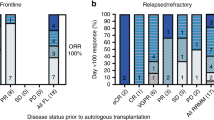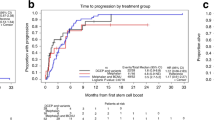Abstract
Extensive studies have tested the clinical impact of double and triple sequential transplants as front-line therapy in MM, following the suggestion that dose escalation can overcome the marked drug resistance characteristic of this disease, but the superiority of such approaches vsone single transplant has still to be demonstrated. The aim of our study was to evaluate the feasibility and efficacy of high-dose idarubicine intensification of a standard busulphan–melphalan conditioning regimen in MM. Twenty-eight patients (median age 55 years) with sensitive disease received PBSCT after high-dose idarubicine combined with busulphan and melphalan and followed by s.c. rhG-CSF until PMN recovery. The most severe toxicity was represented by oral mucositis which resolved with hemopoietic reconstitution. Overall response and CR rate were 52% and 40%, respectively. Currently, 36 patients are alive and 19 are progression-free a median of 20 months (12–36) from transplant. The 3-year projected probability of progression-free survival for patients transplanted after first-line treatment is 60%. The combination of Ida/Bu/Melph appears a promising alternative regimen for PBSCT in myeloma, with low transplant-related toxicity and fast hematological recovery. Long-term follow-up and a prospective randomized study, now ongoing, will probably clarify whether an idarubicine-intensified regimen will result in superior outcomes to conventional conditioning and even be comparable to a double consecutive transplant program. Bone Marrow Transplantation (2000) 26, 1045–1049.
This is a preview of subscription content, access via your institution
Access options
Subscribe to this journal
Receive 12 print issues and online access
$259.00 per year
only $21.58 per issue
Buy this article
- Purchase on Springer Link
- Instant access to full article PDF
Prices may be subject to local taxes which are calculated during checkout

Similar content being viewed by others
References
Barlogie, B, Epstein J, Selvanayagam P, Alexanian R . Plasma cell myeloma: new biological insights and advances in therapy Blood 1989 73: 865–879
Alexanian R, Dimopoulos M . The treatment of multiple myeloma New Engl J Med 1994 330: 484–489
Bergsagel DE . Is aggressive chemotherapy more effective in the treatment of plasma cell myeloma? Eur J Cancer Clin Oncol 1989 25: 159–161
Gregory WM, Richards MA, Malpas J . Combination chemotherapy versus melphalan prednisone in the treatment of multiple myeloma: an overview of published trials J Clin Oncol 1992 10: 334–342
Lokhorst HM, Meuwissen OJ, Verdonck LF, Dekker AW . High-risk multiple myeloma treated with high-dose melphalan J Clin Oncol 1992 10: 47–51
Cunningham D, Paz-Ares L, Gore ME et al. High-dose melphalan for multiple myeloma: long-term follow-up data J Clin Oncol 1994 12: 764–768
Barlogie B, Alexanian R, Dicke KA et al. High dose chemoradiotherapy and autologous bone marrow transplantation for resistant multiple myeloma Blood 1987 70: 869–872
Harousseau JL, Milpied N, Garand R, Bourhis JH . High dose melphalan and autologous bone marrow transplantation in high risk myeloma Br J Haematol 1987 67: 493
Jagannath S, Barlogie B, Dicke K et al. Autologous bone marrow transplantation in multiple myeloma: identification of prognostic factors Blood 1990 76: 1860–1866
Cunningham D, Paz-Ares L, Milan S et al. High-dose melphalan and autologous bone marrow transplantation as consolidation in previously untreated myeloma J Clin Oncol 1994 12: 759–763
Attal M, Harousseau JL, Stoppa AM et al. A prospective, randomized trial of autologous bone marrow transplantation and chemotherapy in multiple myeloma. Intergroupe Francais du Myelome New Engl J Med 1996 335: 91–97
Barlogie B, Jagannath S, Vesole D, Tricot G . Hematopoietic stem cell autografts in support of myeloablative therapy for multiple myeloma J Hematother 1994 3: 149–153
Harousseau JL, Attal M, Divine M et al. Autologous stem cell transplantation after first remission induction treatment in multiple myeloma: a report of the French registry on autologous transplantation in multiple myeloma Blood 1995 85: 3077–3085
Fernand JP, Chevret S, Ravaud P et al. High dose chemoradiotherapy and autologous blood stem cell transplantation in multiple myeloma: results of phase II trial involving 63 patients Blood 1993 82: 2005–2009
Alegre A, Lamana M, Arranz R et al. Busulfan and melphalan as conditioning regimen for autologous peripheral blood stem cell transplantation in multiple myeloma Br J Haematol 1995 91: 380–386
Vesole DH, Barlogie B, Jagannath S et al. High-dose therapy refractory multiple myeloma: improved prognosis with better supportive care and double transplants Blood 1994 84: 950–956
Jourdan E, Blaise D, Fegueux N et al. Third autologous stem cell transplants for late relapse of multiple myeloma Bone Marrow Transplant 1996 17: 885–886
Barlogie B, Jagannath S, Vesole D et al. Superiority of tandem autologous transplantation over standard therapy for previously untreated multiple myeloma Blood 1997 89: 789–793
Muus P, Donnelly A, Schattemberg P et al. Idarubicin related side effects recipients of T-cell depleted allogeneic bone marrow transplants are schedule dependent Semin Oncol 1993 6: 47–52
Raemaekers J, De Witte T, Schattemberg A et al. Prevention of leukemic relapse after transplantation with lymphocyte-depleted marrow by intensification of the conditioning regimen with a 6-day continuous infusion of anthracyclines Bone Marrow Transplant 1989 4: 167–171
Muus P, De Witte T, Schattemberg A et al. Intensification of the conditioning regimen for allogeneic bone marrow transplantation in recipients of T-cell depleted grafts by the addition of anthracyclines Leuk Lymphoma 1992 7: 11–14
Jerjis, S, Roovers E, Muus P et al. Idarubicin to intensify the conditioning regimen of autologous bone marrow transplantation for patients with acute myeloid leukemia in first complete remission Bone Marrow Transplant 1998 22: 13–19
Tribalto M, Amadori S, Cudillo L et al. Autologous peripheral blood stem cell transplantation as first line treatment of multiple myeloma: an Italian multicenter study Haematologica 2000 85: 52–58
Lo Coco F, Mandelli F, Diverio D et al. Therapy induced Ph1 suppression in chronic myeloid leukemia: molecular and cytogenetic studies in patients treated with alpha-2b IFN, high-dose chemotherapy and autologous stem cell infusion Bone Marrow Transplant 1990 6: 253–258
World Health Organization WHO Handbook for Reporting Results of Cancer Treatment World Health Organization: Geneva 1979 pp 38
Heyll A, Sohngen D, Kobbe G et al. Idarubicin, melphalan and cyclophosphamide: an intensified high-dose regimen for the treatment of myeloma patients Leukemia 1997 11: 32–34
San Miguel JF, Blade Creixenty J, Garcia-Sanz R . Treatment of multiple myeloma Haematologica 1999 84: 36–58
Harousseau JL . Peripheral blood progenitor cell autologous transplantation in multiple myeloma Haematologica 1999 84: 548–553
Fermand JP, Ravaud P, Chevret S et al. High dose therapy and autologous peripheral blood stem cell transplantation in multiple myeloma: up front or rescue treatment? Results of a multicenter sequential randomized clinical trial Blood 1998 92: 3131–3136
Attal M, Payen C, Facon T et al. Single vs double transplant in myeloma: a randomised trial of the ‘Inter Groupe Francais du Myelome’ (IFM) Bone Marrow Transplant 1998 21: (Suppl. 1) 718
Acknowledgements
We acknowledge the support of Pharmacia and Upjohn in providing idarubicine; we particularly thank Dr Theo De Witte for kindly revising the manuscript. This work was supported by MURST 40%.
Author information
Authors and Affiliations
Rights and permissions
About this article
Cite this article
Meloni, G., Capria, S., Trasarti, S. et al. High-dose idarubicine, busulphan and melphalan as conditioning for autologous blood stem cell transplantation in multiple myeloma. A feasibility study. Bone Marrow Transplant 26, 1045–1049 (2000). https://doi.org/10.1038/sj.bmt.1702668
Received:
Accepted:
Published:
Issue Date:
DOI: https://doi.org/10.1038/sj.bmt.1702668



